If she could perfectly play sweet and restrained characters in films, she was quite different in real life, as periods of estrangement from her daughters and her sister would suggest. However, Joan’s relationship with some other people seems to have been more cordial. Susan Pfeiffer, her secretary in later years, described her as 'one of the kindest, loving women I have ever met' and Police Officer Bill Cassara, who met her in 1997 and befriended her, reminisced in 2021 about 'her warm conversation and company'.
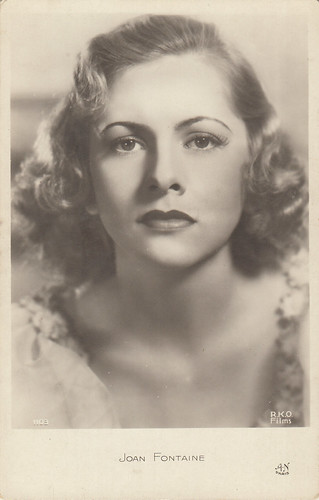
French postcard by A.N. Paris, no. 1103. Photo: RKO Films.
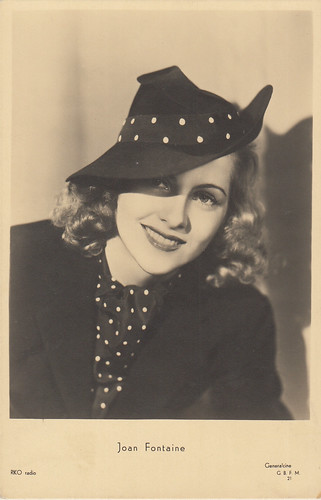
Italian postcard by G.B. Falci Editore, Milano, no. 21. Photo: RKO Radio.
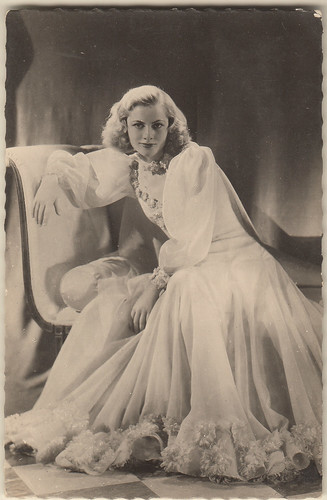
Dutch postcard by Vigevano Amsterdam, no. 3909.
Joan Fontaine was born Joan de Havilland on the 17th of October 1917 in Tokyo, Japan, to British parents, Walter de Havilland and Lilian Ruse.
She had an older sister who would also become a famous film star: Olivia de Havilland.
In 1919, her mother relocated to the U.S.A. with her two daughters. Shortly after her divorce from Walter de Havilland had been granted, Lilian married George Fontaine in 1925.
In her teenage years, Joan went to live for some time with her father in Tokyo and then came back to the U.S.A. permanently. In the mid-1930s, she decided to follow in the footsteps of her sister Olivia, who had embarked into to an acting career.
After some stage work, Joan made her screen debut, as Joan Burfield, in No More Ladies (1935), a Joan Crawford vehicle. In 1936, she was noticed in the play 'Call It a Day' and soon got a movie contract at R.K.O. At the time, she had chosen to call herself Joan Fontaine, after her stepfather’s surname.
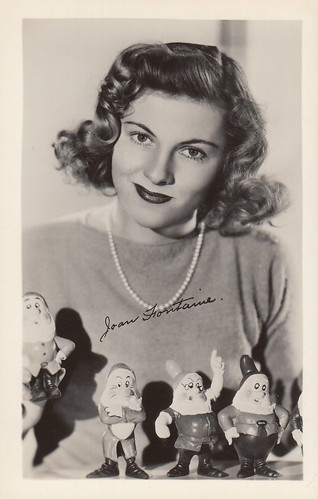
American postcard. Joan Fontaine posing with several of the seven dwarfs from the famous Walt Disney movie.
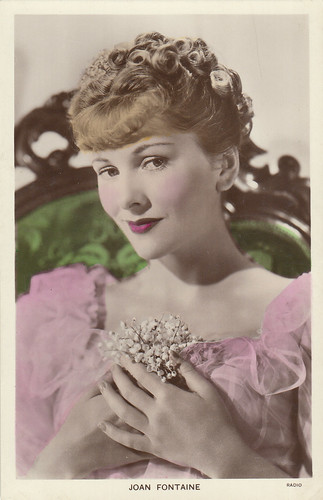
British postcard in the Colourgraph Series, no. C317. Photo: Radio. Joan Fontaine in Gunga Din (George Stevens, 1939).

Spanish postcard by Soberanas, Barcelona, no. 21. Joan Fontaine in Rebecca (Alfred Hitchcock, 1940).
Her career at R.K.O. was on the whole lacklustre and she often played one-dimensional and unimpressive characters in B movies such as The Man Who Found Himself (1937), Maid’s Night Out (1938) or Blond Cheat (1938).
When she was cast in more prestigious productions, she ran out of luck.
For example, she was handed the plum assignment of appearing opposite Fred Astaire in A Damsel in Distress (1937). Faced with her lack of terpsichorean skills, R.K.O. gave her only one dancing scene with Astaire but the results were so-so. Audiences and critics came to the conclusion that she was no Ginger Rogers and the movie did nothing to boost her career.
Later, she was sixth-billed in the popular adventure film Gunga Din (1939) but, as Douglas Fairbanks Jr.’s rather bland love interest, she didn’t have much more to do than look pretty.
After R.K.O. had not renewed her contract, she went to play Peggy, the most unassuming of the female protagonists of George Cukor’s The Women (1939) who, in the opening credits, is symbolised by a lamb. Anyway, the director was very pleased by the way she handled her part, with naturalness and sensitivity.
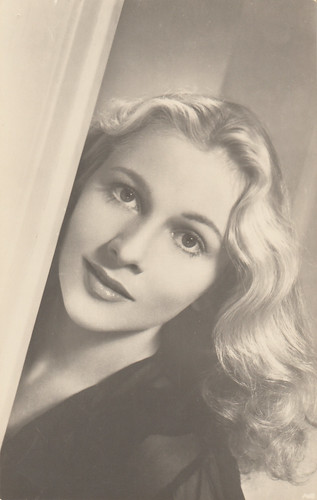
Spanish postcard by Soberanas, no. 718.
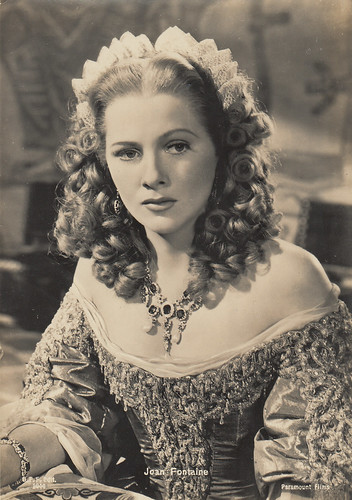
Italian postcard by B.F.F., Firenze, no. 2044. Photo: Paramount Films. Joan Fontaine in Frenchman’s Creek (Mitchell Leisen, 1944).

Dutch postcard by Van Leers’ Fotodrukindustrie, Amsterdam, no. 1250.
In 1938, David O’Selznick bought the movie rights to Daphné du Maurier’s novel 'Rebecca' and started a search to find the perfect actress to play the leading role. Many female performers were considered and tested. After some time, the selection was narrowed to five contenders: Vivien Leigh, Loretta Young, Margaret Sullavan, Anne Baxter and Joan Fontaine, who were subjected to further extensive screen tests.
Selznick soon ruled out Vivien Leigh, who didn’t project enough innocence and who came out as too cunning and flirtatious. He also rejected Young, who looked too glamourous, had a too distinctive American accent and whose acting was deemed unconvincing.
Sullavan managed to achieve an interesting level of emotional intensity but failed to convey fragility and was found too mature to play an inexperienced ingenue in love with an older man. Selznick feared that she would make a too-confident second Mrs de Winter, which wasn’t what he had envisioned for his heroine.
Baxter, who was only 16 years old at the time, was very good and made a strong impression but she looked too young for the part. Although he had some reservations about her acting, Selznick thought that Joan Fontaine could provide the character with appropriate qualities in terms of appearance and personality: she was good-looking but not breathtakingly beautiful and projected the right amount of shyness, awkwardness and vulnerability.
At the end of August 1939, he decided to give her the much-coveted leading role in Rebecca. During filming, director Alfred Hitchcock, who had not been too keen on Selznick’s choice in the first place, did his best to coax Joan into giving a top-notch performance and succeeded beyond all expectations. When Rebecca was released in 1940, she was considered perfect for the role, was nominated for an Oscar (she lost to Ginger Rogers) and became a star.

Spanish postcard by Soberanas, no. 372.
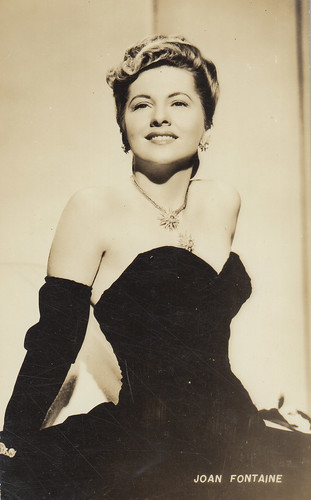
Portuguese postcard by Ediçao Trevo, no. 1969-P. Joan Fontaine in The Affairs of Susan (William A. Seiter, 1945).
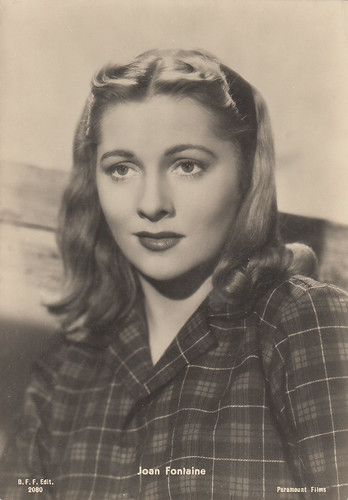
Italian postcard by B.F.F., Firenze, no. 2080. Photo: Paramount Films. Joan Fontaine in The Affairs of Susan (William A. Seiter, 1945).
The forties were Joan Fontaine’s most brilliant decade. She was again directed by Hitchcock in Suspicion (1941), which earned her a Best Actress Oscar.
After a patriotic romance set in war-torn England, This Above All (1942), opposite Tyrone Power, she played touching heroines in The Constant Nymph (1943) and Jane Eyre (1944).
She then looked ravishing in the period costumes of the big-budgeted Frenchman’s Creek (1944). She was a tenement housewife in From This Day Forward (1946) and an evil poisoner in Ivy (1947).
She co-starred with Bing Crosby in the box-office hit The Emperor’s Waltz (1948) and with Burt Lancaster in the Film Noir Kiss the Blood Off My Hands (1948). Letter from an Unknown Woman (1948), directed by Max Ophuls, failed to attract audiences but has since become a classic. She also had a welcome change of pace in two comedies: The Affairs of Susan (1945) and You Gotta Stay Happy (1948).
She began the fifties by playing a scheming and manipulative social climber in Born to be Bad (1950). Next came the lush September Affair (1950), which was about a doomed love affair between a concert pianist and an unhappily married man. Audiences who were fond of romantic dramas were delighted by this movie, which was partly filmed on the enchanted island of Capri and other beautiful Italian settings.
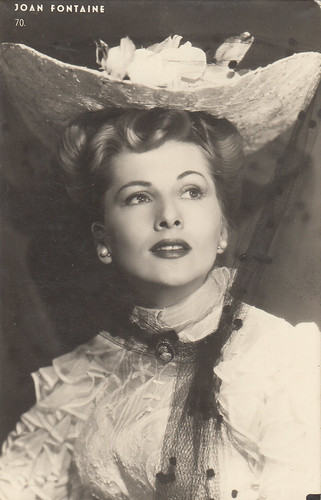
Spanish postcard, no. 70. Joan Fontaine in Ivy (Sam Wood, 1947).
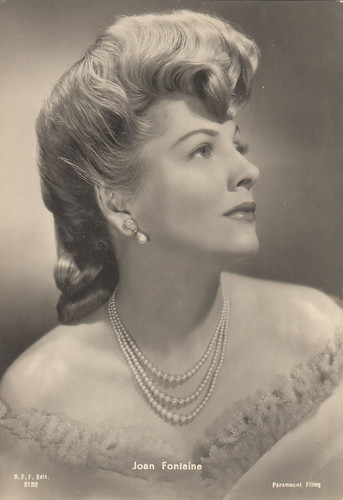
Italian postcard by B.F.F. Edit., no. 2132. Photo: Paramount Films. Joan Fontaine in The Emperor’s Waltz (Billy Wilder, 1948).
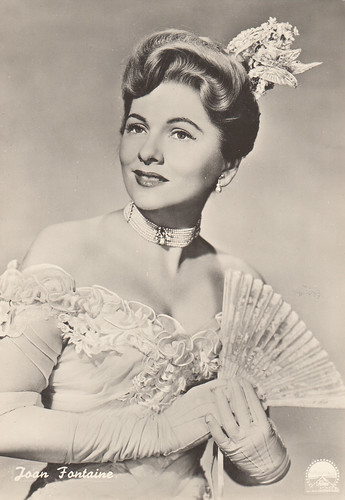
Italian postcard by Bromofoto, Milano, no. 625. Photo: Paramount. Joan Fontaine in The Emperor’s Waltz (Billy Wilder, 1948).
At the beginning of the 1950s, her career went into decline. Darling, How Could You (1951) and Something to Live for (1952) were not very well-received. Decameron Nights (1953) was a tame and unsuccessful attempt to adapt 'Boccaccio' and Flight to Tangier (1953) was a low-caliber programmer.
She had a rather pallid role as Rowena in Ivanhoe (1952) and played second fiddle to Bob Hope in Casanova’s Big Night (1954), which was not one of his best vehicles. She also found it most unpleasant to work with the temperamental Mario Lanza in Serenade (1956). Amidst those unrewarding parts, she gave a good performance as a distant and career-oriented wife, whose husband leads a double life, in The Bigamist (1953), an interesting picture about bigamy directed by Ida Lupino.
After being featured in Fritz Lang’s last Hollywood movie, Beyond a Reasonable Doubt (1956), she signed to join the star-studded cast of the controversial Island in the Sun (1957), which dealt with interracial love themes. On a fictitious West-Indian island, wealthy Mavis Norman (Joan) and handsome labour organiser David Boyeur (Harry Belafonte) are attracted to each other but, in the end, their 'romance' is not consummated and Mavis will leave the island alone. The movie also focused on love affairs between Dorothy Dandridge and John Justin and between Stephen Boyd and Joan Collins, who is mistakingly led to believe that she‘s of mixed race. Despite several negative reactions in the Southern part of the U.S.A., Island in the Sun was a big commercial success.
She then was a spinster who awakens to love in Until They Sail (1957) and Rossano Brazzi’s patient and understanding wife in A Certain Smile (1958), adapted from a novel by Françoise Sagan, who deeply disliked the Hollywood treatment of her book. Maybe the most satisfying feature of this movie was its theme song by Johnny Mathis.
It was followed by the popular Science-Fiction film Voyage to the Bottom of the Sea (1961), in which she played a scientist. Tender Is The Night (1962) was dismissed by most critics but Joan received good reviews for her role as Baby Warren, the heroine’s sister. Her cinematographic career ended in England with the Hammer Horror movie The Witches (1965).
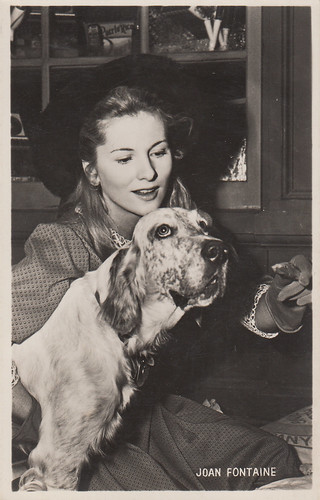
Vintage postcard no. 232. Joan Fontaine in Letter from an Unknown Woman (Max Ophüls, 1948).
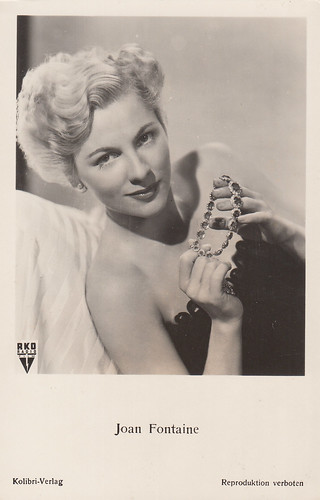
German postcard by Kolibri Verlag. Photo: RKO Radio Pictures. Joan Fontaine in Born to be Bad (Nicholas Ray, 1950).

Italian postcard by B.F.F., Firenze, no. 2131. Photo: Universal International.
In June 1954, she replaced Deborah Kerr in the play 'Tea and Sympathy' on Broadway. She successfully continued with it until February 1955. She later made other occasional stage appearances over the years.
From 1953 to 1994, she also worked now and then for television and got an Emmy Award nomination for Ryan’s Hope in 1980. Her last acting part was as a Czech King’s beloved grandmother in the TV movie Good King Wenceslas (1994).
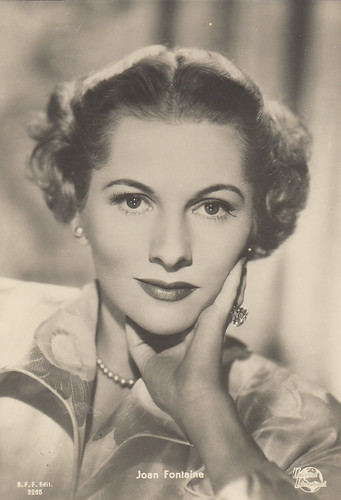
Italian postcard by B.F.F., Firenze, no. 2265. Photo: Universal International.
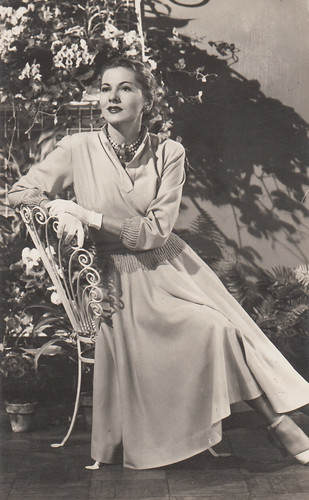
Spanish postcard, no. 1067.
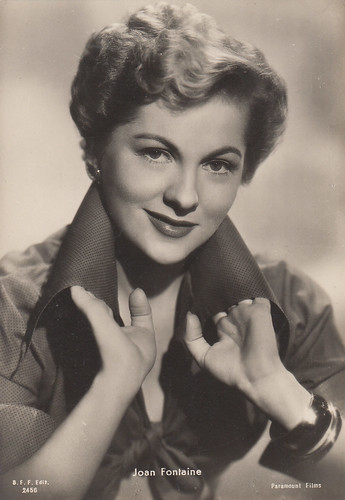
Italian postcard by B.F.F., Firenze, no. 2456. Photo: Paramount Films.
Joan Fontaine married and divorced four times. Her husbands were actor Brian Aherne (1939-1945), producer William Dozier (1946-1951), producer Collier Young (1952-1961) and golf editor of Sports Illustrated Alfred Wright Jr. (1964-1969).
In 1948, she had one daughter, Deborah, from Dozier. In 1951, she brought back Martita, a young Peruvian child, from South America but never formally adopted her.
Deborah and Martita’s relationship with Joan had been at times rocky.
Deborah said: "When she was home and she wanted to be a mother, she was an absolute joy to be around. She could be the most enthusiastic and exuberant person, ever. But then, she’d turned and we were terrified of her. Maybe she was bipolar because you just didn’t know what you were going to get". She also revealed that she was far closer to her aunt, Olivia de Havilland than to her own mother.
Between Martita and Joan, there had been at one time a serious rift, which, after a long period of estrangement, seems to have healed later. Joan Fontaine spent the last years of her life in Carmel, in a beautiful villa overlooking the ocean, and passed away on the 15th of December 2013.
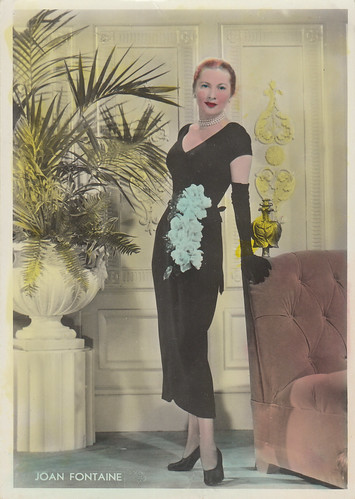
Dutch postcard by Uitgave P.F. Cladder Amsterdam, no. 49-12.
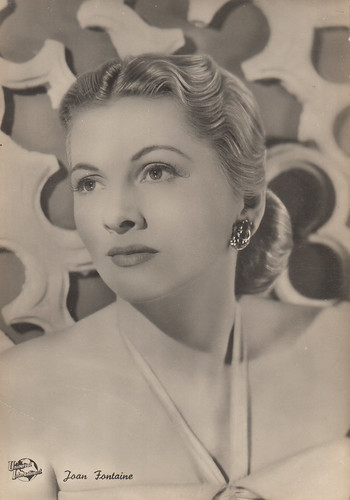
Italian postcard by Rotalfoto, Milano, no. 66. Photo: Universal International.
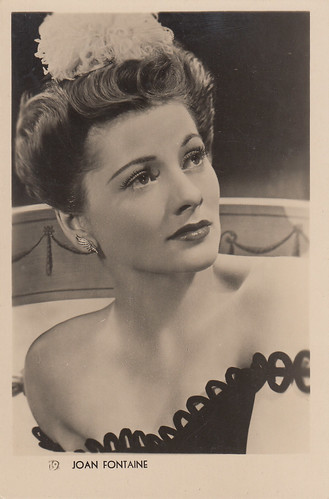
Spanish postcard, no. 19.
So much has been written over the years about the feud between Olivia de Havilland and Joan Fontaine. The two women had very different personalities. Deborah Dozier once said: "Joan was glib, Olivia was gracious". As years went by, the contrast intensified. Joan became more of a jet-setter and has often been termed as sophisticated, witty and brittle, whereas her older sister choose a quiet family life and was described as dignified, proper and level-headed.
It seems that, during childhood, the two sisters already didn’t get along well. Later, professional rivalry came to tax their relationship even more. In February 1941, both sisters were nominated for a Best Actress Oscar and Joan won. Olivia had to wait several years to get hers.
An event at the March 1947 Academy Award ceremony clearly showed how the relationship between the two sisters was strained: when Joan came forward to congratulate Olivia for her first Oscar, she ostensibly turned away from her without a glance. It was said that Olivia hadn’t forgotten or forgiven the remarks her sister allegedly had made in 1946 about her first husband, writer Marcus Goodrich.
Afterwards, Olivia and Joan had a hot-and-cold relationship and still occasionally saw each other. The ties between them suffered a severe blow in 1975 when their mother passed away. Joan, who was on tour at the time, accused her sister of not inviting her to the memorial service and claimed that she had to demand that the ceremony would be delayed until she could attend it. When the event finally took place, they didn’t exchange a word. At an Oscar reunion in 1979, Olivia and Joan had to be placed on separate ends of the stage.
It came as a surprise to everybody when, in a 2013 interview, Joan allegedly said that the two sisters never had a rough patch and never had a quarrel. This was in complete contradiction with statements she had made before such as, in a 1978 interview, "You can divorce your sister as well as your husbands. I don’t see Olivia and I don’t intend to". However, in 2016, Olivia set the record straight and confirmed that they were estranged at the time of Joan’s death in 2013. She described her sister as a multi-faceted person, varying from endearing to alienating, who had astigmatism in her perception of both people and situations.
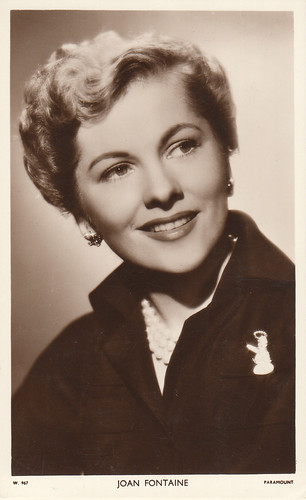
British postcard by Picturegoer, no. W 967. Photo: Paramount.
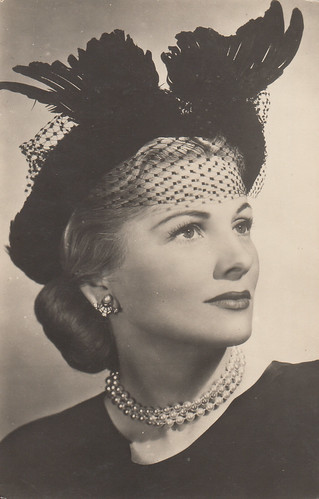
Spanish postcard, no. 43.
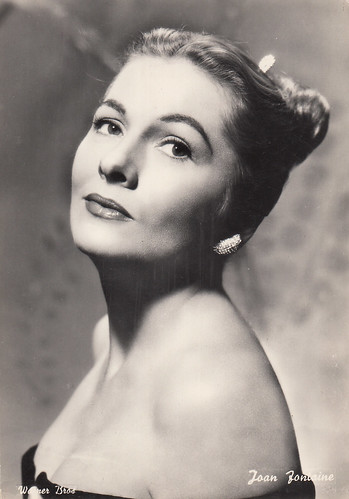
Italian postcard by Bromofoto, Milano, no. 1163. Photo: Warner Bros.
Text and postcards: Marlene Pilaete.

French postcard by A.N. Paris, no. 1103. Photo: RKO Films.

Italian postcard by G.B. Falci Editore, Milano, no. 21. Photo: RKO Radio.

Dutch postcard by Vigevano Amsterdam, no. 3909.
Joan Fontaine’s youth
Joan Fontaine was born Joan de Havilland on the 17th of October 1917 in Tokyo, Japan, to British parents, Walter de Havilland and Lilian Ruse.
She had an older sister who would also become a famous film star: Olivia de Havilland.
In 1919, her mother relocated to the U.S.A. with her two daughters. Shortly after her divorce from Walter de Havilland had been granted, Lilian married George Fontaine in 1925.
In her teenage years, Joan went to live for some time with her father in Tokyo and then came back to the U.S.A. permanently. In the mid-1930s, she decided to follow in the footsteps of her sister Olivia, who had embarked into to an acting career.
After some stage work, Joan made her screen debut, as Joan Burfield, in No More Ladies (1935), a Joan Crawford vehicle. In 1936, she was noticed in the play 'Call It a Day' and soon got a movie contract at R.K.O. At the time, she had chosen to call herself Joan Fontaine, after her stepfather’s surname.

American postcard. Joan Fontaine posing with several of the seven dwarfs from the famous Walt Disney movie.

British postcard in the Colourgraph Series, no. C317. Photo: Radio. Joan Fontaine in Gunga Din (George Stevens, 1939).

Spanish postcard by Soberanas, Barcelona, no. 21. Joan Fontaine in Rebecca (Alfred Hitchcock, 1940).
Undistinguished first Hollywood years
Her career at R.K.O. was on the whole lacklustre and she often played one-dimensional and unimpressive characters in B movies such as The Man Who Found Himself (1937), Maid’s Night Out (1938) or Blond Cheat (1938).
When she was cast in more prestigious productions, she ran out of luck.
For example, she was handed the plum assignment of appearing opposite Fred Astaire in A Damsel in Distress (1937). Faced with her lack of terpsichorean skills, R.K.O. gave her only one dancing scene with Astaire but the results were so-so. Audiences and critics came to the conclusion that she was no Ginger Rogers and the movie did nothing to boost her career.
Later, she was sixth-billed in the popular adventure film Gunga Din (1939) but, as Douglas Fairbanks Jr.’s rather bland love interest, she didn’t have much more to do than look pretty.
After R.K.O. had not renewed her contract, she went to play Peggy, the most unassuming of the female protagonists of George Cukor’s The Women (1939) who, in the opening credits, is symbolised by a lamb. Anyway, the director was very pleased by the way she handled her part, with naturalness and sensitivity.

Spanish postcard by Soberanas, no. 718.

Italian postcard by B.F.F., Firenze, no. 2044. Photo: Paramount Films. Joan Fontaine in Frenchman’s Creek (Mitchell Leisen, 1944).

Dutch postcard by Van Leers’ Fotodrukindustrie, Amsterdam, no. 1250.
Rebecca
In 1938, David O’Selznick bought the movie rights to Daphné du Maurier’s novel 'Rebecca' and started a search to find the perfect actress to play the leading role. Many female performers were considered and tested. After some time, the selection was narrowed to five contenders: Vivien Leigh, Loretta Young, Margaret Sullavan, Anne Baxter and Joan Fontaine, who were subjected to further extensive screen tests.
Selznick soon ruled out Vivien Leigh, who didn’t project enough innocence and who came out as too cunning and flirtatious. He also rejected Young, who looked too glamourous, had a too distinctive American accent and whose acting was deemed unconvincing.
Sullavan managed to achieve an interesting level of emotional intensity but failed to convey fragility and was found too mature to play an inexperienced ingenue in love with an older man. Selznick feared that she would make a too-confident second Mrs de Winter, which wasn’t what he had envisioned for his heroine.
Baxter, who was only 16 years old at the time, was very good and made a strong impression but she looked too young for the part. Although he had some reservations about her acting, Selznick thought that Joan Fontaine could provide the character with appropriate qualities in terms of appearance and personality: she was good-looking but not breathtakingly beautiful and projected the right amount of shyness, awkwardness and vulnerability.
At the end of August 1939, he decided to give her the much-coveted leading role in Rebecca. During filming, director Alfred Hitchcock, who had not been too keen on Selznick’s choice in the first place, did his best to coax Joan into giving a top-notch performance and succeeded beyond all expectations. When Rebecca was released in 1940, she was considered perfect for the role, was nominated for an Oscar (she lost to Ginger Rogers) and became a star.

Spanish postcard by Soberanas, no. 372.

Portuguese postcard by Ediçao Trevo, no. 1969-P. Joan Fontaine in The Affairs of Susan (William A. Seiter, 1945).

Italian postcard by B.F.F., Firenze, no. 2080. Photo: Paramount Films. Joan Fontaine in The Affairs of Susan (William A. Seiter, 1945).
Brilliant years
The forties were Joan Fontaine’s most brilliant decade. She was again directed by Hitchcock in Suspicion (1941), which earned her a Best Actress Oscar.
After a patriotic romance set in war-torn England, This Above All (1942), opposite Tyrone Power, she played touching heroines in The Constant Nymph (1943) and Jane Eyre (1944).
She then looked ravishing in the period costumes of the big-budgeted Frenchman’s Creek (1944). She was a tenement housewife in From This Day Forward (1946) and an evil poisoner in Ivy (1947).
She co-starred with Bing Crosby in the box-office hit The Emperor’s Waltz (1948) and with Burt Lancaster in the Film Noir Kiss the Blood Off My Hands (1948). Letter from an Unknown Woman (1948), directed by Max Ophuls, failed to attract audiences but has since become a classic. She also had a welcome change of pace in two comedies: The Affairs of Susan (1945) and You Gotta Stay Happy (1948).
She began the fifties by playing a scheming and manipulative social climber in Born to be Bad (1950). Next came the lush September Affair (1950), which was about a doomed love affair between a concert pianist and an unhappily married man. Audiences who were fond of romantic dramas were delighted by this movie, which was partly filmed on the enchanted island of Capri and other beautiful Italian settings.

Spanish postcard, no. 70. Joan Fontaine in Ivy (Sam Wood, 1947).

Italian postcard by B.F.F. Edit., no. 2132. Photo: Paramount Films. Joan Fontaine in The Emperor’s Waltz (Billy Wilder, 1948).

Italian postcard by Bromofoto, Milano, no. 625. Photo: Paramount. Joan Fontaine in The Emperor’s Waltz (Billy Wilder, 1948).
Up and downs
At the beginning of the 1950s, her career went into decline. Darling, How Could You (1951) and Something to Live for (1952) were not very well-received. Decameron Nights (1953) was a tame and unsuccessful attempt to adapt 'Boccaccio' and Flight to Tangier (1953) was a low-caliber programmer.
She had a rather pallid role as Rowena in Ivanhoe (1952) and played second fiddle to Bob Hope in Casanova’s Big Night (1954), which was not one of his best vehicles. She also found it most unpleasant to work with the temperamental Mario Lanza in Serenade (1956). Amidst those unrewarding parts, she gave a good performance as a distant and career-oriented wife, whose husband leads a double life, in The Bigamist (1953), an interesting picture about bigamy directed by Ida Lupino.
After being featured in Fritz Lang’s last Hollywood movie, Beyond a Reasonable Doubt (1956), she signed to join the star-studded cast of the controversial Island in the Sun (1957), which dealt with interracial love themes. On a fictitious West-Indian island, wealthy Mavis Norman (Joan) and handsome labour organiser David Boyeur (Harry Belafonte) are attracted to each other but, in the end, their 'romance' is not consummated and Mavis will leave the island alone. The movie also focused on love affairs between Dorothy Dandridge and John Justin and between Stephen Boyd and Joan Collins, who is mistakingly led to believe that she‘s of mixed race. Despite several negative reactions in the Southern part of the U.S.A., Island in the Sun was a big commercial success.
She then was a spinster who awakens to love in Until They Sail (1957) and Rossano Brazzi’s patient and understanding wife in A Certain Smile (1958), adapted from a novel by Françoise Sagan, who deeply disliked the Hollywood treatment of her book. Maybe the most satisfying feature of this movie was its theme song by Johnny Mathis.
It was followed by the popular Science-Fiction film Voyage to the Bottom of the Sea (1961), in which she played a scientist. Tender Is The Night (1962) was dismissed by most critics but Joan received good reviews for her role as Baby Warren, the heroine’s sister. Her cinematographic career ended in England with the Hammer Horror movie The Witches (1965).

Vintage postcard no. 232. Joan Fontaine in Letter from an Unknown Woman (Max Ophüls, 1948).

German postcard by Kolibri Verlag. Photo: RKO Radio Pictures. Joan Fontaine in Born to be Bad (Nicholas Ray, 1950).

Italian postcard by B.F.F., Firenze, no. 2131. Photo: Universal International.
On stage and on television
In June 1954, she replaced Deborah Kerr in the play 'Tea and Sympathy' on Broadway. She successfully continued with it until February 1955. She later made other occasional stage appearances over the years.
From 1953 to 1994, she also worked now and then for television and got an Emmy Award nomination for Ryan’s Hope in 1980. Her last acting part was as a Czech King’s beloved grandmother in the TV movie Good King Wenceslas (1994).

Italian postcard by B.F.F., Firenze, no. 2265. Photo: Universal International.

Spanish postcard, no. 1067.

Italian postcard by B.F.F., Firenze, no. 2456. Photo: Paramount Films.
Her private life
Joan Fontaine married and divorced four times. Her husbands were actor Brian Aherne (1939-1945), producer William Dozier (1946-1951), producer Collier Young (1952-1961) and golf editor of Sports Illustrated Alfred Wright Jr. (1964-1969).
In 1948, she had one daughter, Deborah, from Dozier. In 1951, she brought back Martita, a young Peruvian child, from South America but never formally adopted her.
Deborah and Martita’s relationship with Joan had been at times rocky.
Deborah said: "When she was home and she wanted to be a mother, she was an absolute joy to be around. She could be the most enthusiastic and exuberant person, ever. But then, she’d turned and we were terrified of her. Maybe she was bipolar because you just didn’t know what you were going to get". She also revealed that she was far closer to her aunt, Olivia de Havilland than to her own mother.
Between Martita and Joan, there had been at one time a serious rift, which, after a long period of estrangement, seems to have healed later. Joan Fontaine spent the last years of her life in Carmel, in a beautiful villa overlooking the ocean, and passed away on the 15th of December 2013.

Dutch postcard by Uitgave P.F. Cladder Amsterdam, no. 49-12.

Italian postcard by Rotalfoto, Milano, no. 66. Photo: Universal International.

Spanish postcard, no. 19.
The famous feud
So much has been written over the years about the feud between Olivia de Havilland and Joan Fontaine. The two women had very different personalities. Deborah Dozier once said: "Joan was glib, Olivia was gracious". As years went by, the contrast intensified. Joan became more of a jet-setter and has often been termed as sophisticated, witty and brittle, whereas her older sister choose a quiet family life and was described as dignified, proper and level-headed.
It seems that, during childhood, the two sisters already didn’t get along well. Later, professional rivalry came to tax their relationship even more. In February 1941, both sisters were nominated for a Best Actress Oscar and Joan won. Olivia had to wait several years to get hers.
An event at the March 1947 Academy Award ceremony clearly showed how the relationship between the two sisters was strained: when Joan came forward to congratulate Olivia for her first Oscar, she ostensibly turned away from her without a glance. It was said that Olivia hadn’t forgotten or forgiven the remarks her sister allegedly had made in 1946 about her first husband, writer Marcus Goodrich.
Afterwards, Olivia and Joan had a hot-and-cold relationship and still occasionally saw each other. The ties between them suffered a severe blow in 1975 when their mother passed away. Joan, who was on tour at the time, accused her sister of not inviting her to the memorial service and claimed that she had to demand that the ceremony would be delayed until she could attend it. When the event finally took place, they didn’t exchange a word. At an Oscar reunion in 1979, Olivia and Joan had to be placed on separate ends of the stage.
It came as a surprise to everybody when, in a 2013 interview, Joan allegedly said that the two sisters never had a rough patch and never had a quarrel. This was in complete contradiction with statements she had made before such as, in a 1978 interview, "You can divorce your sister as well as your husbands. I don’t see Olivia and I don’t intend to". However, in 2016, Olivia set the record straight and confirmed that they were estranged at the time of Joan’s death in 2013. She described her sister as a multi-faceted person, varying from endearing to alienating, who had astigmatism in her perception of both people and situations.

British postcard by Picturegoer, no. W 967. Photo: Paramount.

Spanish postcard, no. 43.

Italian postcard by Bromofoto, Milano, no. 1163. Photo: Warner Bros.
Text and postcards: Marlene Pilaete.
No comments:
Post a Comment